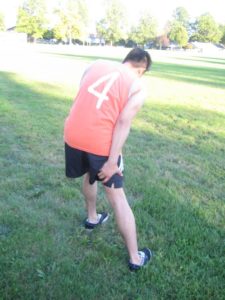A hamstring strain causes abrupt sharp pain at the rear part of the thigh. The hamstring group is comprised of 3 separate muscles that originate from the lower region of the pelvis and insert into the back of the tibia.
Acute or abrupt strains typically occur in 2 ways, either related to sprinting or stretching especially in gymnastics, martial arts or dancing. During sprinting, the muscles strain excessively to decelerate the tibia before the foot hits the ground and it is the time when the hamstring is likely to tear. The stretch-related injuries occur at a higher region at the rear of the thigh in the tendon of the semimembranosus muscle.
A hamstring strain related to sprinting is often agonizing but recover rapidly while the stretching-related strains take a longer time to heal since the tendon is involved in which there is limited blood flow.

What are the indications?
The indications of a hamstring strain include abrupt agonizing pain at the rear of the thigh usually while sprinting or rapid stretching movement or high kick.
A strain is categorized as grade 1, 2 or 3 depending on the severity. A grade 1 injury might only have a slight twinge while a grade 3 strain causes inability to walk along with swelling and bruising after.
The doctor might request an MRI to determine the precise location and extent of the injury so that an accurate diagnosis can be given and estimate the recovery time.
Management of a hamstring strain
The treatment for a hamstring strain is categorized into immediate care and long-term care that starts after the initial phase has passed.
The immediate care includes the PRICE method (protection, rest, ice, compression, elevation) which lasts for 3-4 days depending on the severity. The application of ice and compression must be started right away for 10-15 minutes every hour during the first day.
After this phase, the application every 2-3 hours is enough. A compression bandage can be used to reduce the bleeding in the muscle and swelling. The individual should rest as much as possible with the leg raised to promote drainage of the fluids in the tissue.
Sports massage technique and electrotherapy such as ultrasound can be used along with a rehabilitation program that includes strengthening, stretching and functional exercises.
The foam roller exercises for the hamstring muscles works by massaging and applying myofascial release to the muscles. The pressure is applied above the knee upwards following the direction of the blood flow.
Quick Note / Disclaimer
The material posted on this page on a hamstring strain is for learning and educational purposes only. To learn to recognize and manage strains including on the hamstring, register for a first aid and CPR course with Red Deer First Aid.
